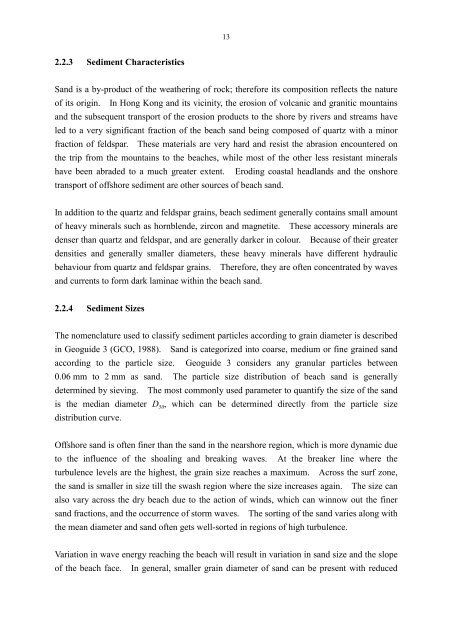PORT WORKS DESIGN MANUAL PART 5 Guide to Design of ...
PORT WORKS DESIGN MANUAL PART 5 Guide to Design of ...
PORT WORKS DESIGN MANUAL PART 5 Guide to Design of ...
You also want an ePaper? Increase the reach of your titles
YUMPU automatically turns print PDFs into web optimized ePapers that Google loves.
13<br />
2.2.3 Sediment Characteristics<br />
Sand is a by-product <strong>of</strong> the weathering <strong>of</strong> rock; therefore its composition reflects the nature<br />
<strong>of</strong> its origin. In Hong Kong and its vicinity, the erosion <strong>of</strong> volcanic and granitic mountains<br />
and the subsequent transport <strong>of</strong> the erosion products <strong>to</strong> the shore by rivers and streams have<br />
led <strong>to</strong> a very significant fraction <strong>of</strong> the beach sand being composed <strong>of</strong> quartz with a minor<br />
fraction <strong>of</strong> feldspar. These materials are very hard and resist the abrasion encountered on<br />
the trip from the mountains <strong>to</strong> the beaches, while most <strong>of</strong> the other less resistant minerals<br />
have been abraded <strong>to</strong> a much greater extent. Eroding coastal headlands and the onshore<br />
transport <strong>of</strong> <strong>of</strong>fshore sediment are other sources <strong>of</strong> beach sand.<br />
In addition <strong>to</strong> the quartz and feldspar grains, beach sediment generally contains small amount<br />
<strong>of</strong> heavy minerals such as hornblende, zircon and magnetite. These accessory minerals are<br />
denser than quartz and feldspar, and are generally darker in colour. Because <strong>of</strong> their greater<br />
densities and generally smaller diameters, these heavy minerals have different hydraulic<br />
behaviour from quartz and feldspar grains. Therefore, they are <strong>of</strong>ten concentrated by waves<br />
and currents <strong>to</strong> form dark laminae within the beach sand.<br />
2.2.4 Sediment Sizes<br />
The nomenclature used <strong>to</strong> classify sediment particles according <strong>to</strong> grain diameter is described<br />
in Geoguide 3 (GCO, 1988). Sand is categorized in<strong>to</strong> coarse, medium or fine grained sand<br />
according <strong>to</strong> the particle size. Geoguide 3 considers any granular particles between<br />
0.06 mm <strong>to</strong> 2 mm as sand. The particle size distribution <strong>of</strong> beach sand is generally<br />
determined by sieving. The most commonly used parameter <strong>to</strong> quantify the size <strong>of</strong> the sand<br />
is the median diameter D 50 , which can be determined directly from the particle size<br />
distribution curve.<br />
Offshore sand is <strong>of</strong>ten finer than the sand in the nearshore region, which is more dynamic due<br />
<strong>to</strong> the influence <strong>of</strong> the shoaling and breaking waves. At the breaker line where the<br />
turbulence levels are the highest, the grain size reaches a maximum. Across the surf zone,<br />
the sand is smaller in size till the swash region where the size increases again. The size can<br />
also vary across the dry beach due <strong>to</strong> the action <strong>of</strong> winds, which can winnow out the finer<br />
sand fractions, and the occurrence <strong>of</strong> s<strong>to</strong>rm waves. The sorting <strong>of</strong> the sand varies along with<br />
the mean diameter and sand <strong>of</strong>ten gets well-sorted in regions <strong>of</strong> high turbulence.<br />
Variation in wave energy reaching the beach will result in variation in sand size and the slope<br />
<strong>of</strong> the beach face. In general, smaller grain diameter <strong>of</strong> sand can be present with reduced

















